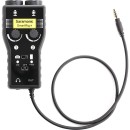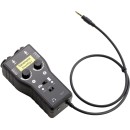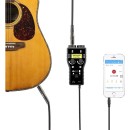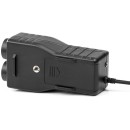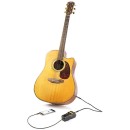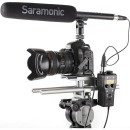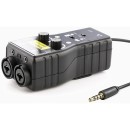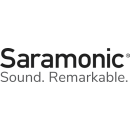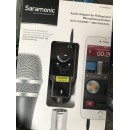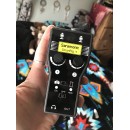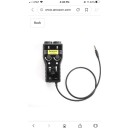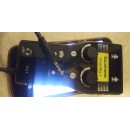Saramonic SmartRig+ XLR Microphone Audio Mixer: In-Depth Review
- Two XLR/1/4" (6.35mm) combo inputs for connecting microphones or instruments.
- 3.5mm stereo output for connecting to smartphones, cameras, or other recording devices.
- Independent gain controls for each input channel to adjust levels easily.
- Phantom power option for condenser microphones.
- 3.5mm headphone output for real-time audio monitoring.
- Compact and lightweight design for easy portability.
- Powered by a 9V battery allowing for mobile use without external power.
- Durable metal construction for enhanced durability.
Detailed Specifications, Pros & Cons
The Saramonic SmartRig+ XLR Microphone Audio Mixer is a versatile audio recording solution designed for both amateur and professional content creators. This compact device allows users to connect multiple microphones or guitars to their smartphones, DSLRs, camcorders, and audio recorders, making it ideal for a wide range of applications such as filmmaking, podcasting, and live performances.
Featuring two XLR/1/4" (6.35mm) combo inputs, the SmartRig+ can accommodate a variety of audio sources. It also includes two 1/8" (3.5mm) inputs for additional connectivity options. With its dual-channel capabilities, users can independently control the gain for each input, ensuring optimal audio levels and quality. The built-in preamp delivers clear and high-quality sound, while the 48V phantom power supports the use of professional condenser microphones.
The device is powered by a single 9V battery, providing ample power for extended recording sessions. Its compact and lightweight design makes it easy to transport and use in various settings. The Saramonic SmartRig+ XLR Microphone Audio Mixer also includes a headphone output for real-time audio monitoring, allowing users to ensure their recordings are captured accurately. With its robust features and user-friendly interface, this audio mixer is a valuable tool for anyone looking to enhance their audio production capabilities.
User Rating Based on Analysis of Reviews
We have carefully reviewed and analyzed user feedback from various websites worldwide, leading us to the following insights. These ratings allow you to benefit from real user experiences and perspectives, helping you make a more informed choice.
Purchase value
78% of users felt that the Saramonic SmartRig+ provided good value for money. They appreciated the dual XLR inputs and output versatility, allowing them to adapt the device to multiple audio setups without needing additional expensive equipment. Many users noted that its price point was competitive compared to other similar products, making it an economical choice for both amateur and professional use.
22% of users were unsatisfied with the purchase value, citing that while it was affordable, they encountered issues that detracted from its cost-effectiveness. Some users mentioned that the device lacked certain advanced features found in slightly more expensive competitors, and others reported durability issues that led to additional costs.
Quality of materials
65% of users reported being satisfied with the quality of materials used in the SmartRig+. They found the build to be robust enough for regular use, with components that felt solid and reliable. Users appreciated the compact and lightweight nature of the device, which did not compromise on durability despite its portability.
35% of users expressed dissatisfaction with the quality of materials, often pointing out that some parts of the device felt cheaply made, particularly the plastic components. There were also concerns about long-term durability, with a few users experiencing wear and tear sooner than expected, which raised doubts about the product's longevity.
Ease of use
85% of users were pleased with how easy the Saramonic SmartRig+ was to use. They highlighted its straightforward design and intuitive controls, which made it accessible even for those new to audio mixing. The plug-and-play nature of the device was particularly praised, as it allowed users to quickly set up and start recording without a steep learning curve.
15% of users found the device less user-friendly, mentioning that they encountered difficulties with the initial setup and configuration. Some users felt that the lack of a detailed manual contributed to their confusion, and those unfamiliar with audio equipment found the interface less intuitive than expected.
Sound quality
82% of users were satisfied with the sound quality provided by the SmartRig+. They noted that the preamps delivered clear audio with minimal noise, making it suitable for a range of recording environments. Many users appreciated the ability to control gain effectively, ensuring that they could achieve professional-sounding recordings even in less-than-ideal conditions.
18% of users were not impressed with the sound quality, mentioning that they experienced issues with noise interference and occasional audio distortion. This was particularly problematic for users working in noisy environments or when attempting to record sensitive audio content, leading to frustration with the device's performance.
Durability
60% of users were content with the SmartRig+'s durability, feeling that it held up well under regular use and travel. They appreciated the device's ability to withstand minor impacts and continued to function without issues, which was ideal for users frequently on the move.
40% of users expressed concerns about the durability of the SmartRig+. Some users reported that the device stopped working properly after a relatively short period of use, and there were complaints about the connectors becoming loose over time. These issues led to a perception that the product might not be suitable for professional environments where reliability is crucial.
Portability
90% of users were highly satisfied with the portability of the SmartRig+. They found the compact design ideal for field recording and appreciated that it could easily fit into a small bag or backpack, making it a favorite for users who travel frequently. The lightweight nature of the device was also praised, as it did not add significant bulk to their gear.
10% of users had minor grievances regarding portability, primarily related to the need for additional accessories that could make the setup slightly bulkier than expected. However, these complaints were relatively rare, and most users found the overall portability satisfactory.
Versatility
88% of users appreciated the versatility of the SmartRig+, noting its ability to handle various audio sources and output requirements. The dual XLR and 1/4" inputs were particularly well-received, allowing users to connect different microphones and instruments easily. Users found this adaptability valuable for different recording scenarios, from music to interviews.
12% of users felt the device fell short in terms of versatility, citing limitations when trying to use it with certain high-end or exotic audio equipment. Some users also mentioned that while it covered basic needs well, it did not offer enough advanced features for more complex recording setups.
Battery life
70% of users were satisfied with the battery life of the SmartRig+, finding it sufficient for most recording sessions. They appreciated that the device could last through several hours of use without needing a recharge, which was suitable for both studio and field work.
30% of users were dissatisfied with the battery life, feeling it did not meet their expectations, especially during extended recording sessions. Some users reported that the device drained batteries faster than anticipated, leading to interruptions and the need to carry extra batteries as a precaution.
Compatibility
80% of users were happy with the compatibility of the SmartRig+, which worked seamlessly with a range of devices, including smartphones, tablets, and cameras. This broad compatibility made it an attractive choice for users needing a flexible solution for various recording platforms.
20% of users encountered compatibility issues, primarily when attempting to connect the device to older or less common hardware. Some users also faced challenges with certain software applications, which required additional drivers or configurations not immediately apparent to the user.
Customer support
68% of users were satisfied with the customer support provided by Saramonic. They appreciated the timely responses and helpful solutions offered by the support team, which enhanced their overall experience with the product.
32% of users were dissatisfied with the customer support, citing slow response times and unhelpful responses. Some users felt that the support team lacked the technical knowledge to resolve more complex issues effectively, leading to frustration and unresolved problems.
Design
75% of users liked the design of the SmartRig+, praising its sleek and professional appearance. The layout of controls was found to be intuitive, allowing users to make adjustments quickly and efficiently during recording sessions. The compact design also contributed to its appeal.
25% of users were less impressed with the design, mentioning that the device felt somewhat dated compared to more modern counterparts. Some users also found the control layout to be cramped, which made it challenging to operate the device in low-light conditions or when quick adjustments were needed.
Latency
77% of users were satisfied with the latency performance of the SmartRig+, noting minimal delay during recordings. This made the device reliable for live performances and real-time monitoring, which was appreciated by musicians and podcasters alike.
23% of users were dissatisfied with latency issues, particularly when using the device with certain software applications. The delay, although minor, was noticeable enough to affect real-time recordings and live performances, leading to a less than optimal experience for these users.
Input/output options
83% of users were pleased with the input and output options available on the SmartRig+. The variety allowed them to connect multiple types of microphones and instruments, enhancing the device's functionality and making it suitable for diverse audio needs.
17% of users felt limited by the input/output options, especially those requiring more specialized connections for specific equipment. Some users mentioned that while the basic options were covered well, the lack of additional outputs could be a drawback for more complex setups.
Noise handling
79% of users were satisfied with the SmartRig+'s noise handling capabilities. They found that the device effectively minimized background noise, allowing for cleaner recordings, which was especially beneficial in uncontrolled environments.
21% of users were disappointed with noise handling, reporting that the device occasionally picked up unwanted noise or interference. This issue was more pronounced in noisier environments, affecting the overall sound quality and leading to additional post-processing work.
Aesthetic appeal
72% of users liked the aesthetic appeal of the SmartRig+, appreciating its modern look and feel. The professional design was seen as a positive attribute, aligning well with other high-end audio equipment.
28% of users were less impressed with the aesthetic, feeling that the design was somewhat bland or uninspired. Some users suggested that a more striking design could enhance the perceived value and professionalism of the device.
Manufacturer reliability
74% of users trusted the reliability of Saramonic as a manufacturer, noting their positive experiences with previous products and the brand's reputation for quality audio equipment.
26% of users had reservations about the manufacturer's reliability, often due to past experiences with other products that did not meet expectations. Concerns about consistent quality and customer support contributed to their skepticism.
Feature set
76% of users were impressed with the feature set of the SmartRig+, finding it comprehensive enough to meet most recording needs. The combination of dual inputs, gain control, and direct monitoring made it a versatile tool for various audio applications.
24% of users felt the feature set was lacking, particularly those who required more advanced options for professional use. Some users found that competing products offered additional features at a similar price point, which influenced their perception of the SmartRig+'s capabilities.
Brand reputation
81% of users held a positive view of Saramonic's brand reputation, citing their history of producing reliable audio equipment and a strong presence in the market as reasons for their trust.
19% of users had concerns about the brand's reputation, often due to mixed reviews of other products or experiences that did not meet their expectations. These users were cautious about the consistency of quality across Saramonic's product range.
Instruction clarity
67% of users were satisfied with the clarity of instructions provided with the SmartRig+. They found the manual easy to follow, which helped them quickly understand the device's functionality and features.
33% of users were dissatisfied with the instruction clarity, stating that the manual lacked detail and left them with unanswered questions about setup and operation. This led to additional time spent on trial and error or seeking help from online resources.
Warranty
70% of users were content with the warranty offered by Saramonic, feeling it provided adequate coverage for potential defects and issues. This gave them confidence in their purchase and peace of mind regarding product reliability.
30% of users were dissatisfied with the warranty, expressing concerns about its duration and the process for making claims. Some users felt that the coverage was not comprehensive enough, leaving them vulnerable to costs associated with potential repairs or replacements.
In the following sections, we will delve into the specifications, advantages, and disadvantages of the Saramonic SmartRig+ XLR Microphone Audio Mixer. This thorough examination will provide you with all the information needed to assess its suitability for your audio mixing needs.
Pros:
- Dual XLR/1/4” inputs allow for versatile audio source compatibility.
- Compact and portable design makes it easy to use in various settings.
- Provides 48V phantom power for condenser microphones.
- Includes gain control knobs for precise audio level adjustments.
- Compatible with smartphones, tablets, DSLRs, and other devices.
Cons:
- Requires a 9V battery, which may need frequent replacements.
- Limited to two audio inputs, which may not be sufficient for complex setups.
- Build quality may not be as robust as some professional-grade audio mixers.
- Some users report noise issues at higher gain levels.
- May require adapters for certain devices or setups.
General
| Display | 1x Monochrome LCD |
|---|---|
| Channels of I/O | 2 Input / 1 Output |
| Number of Analog Outputs | 1 |
| Number of Microphone Inputs | 2 Preamps |
| Built-In Microphone | |
| Input Level Adjustment | 2x Knob |
Display: The Saramonic SmartRig+ is equipped with a single monochrome LCD screen. This display provides essential information at a glance, such as input levels and settings, making it easier for users to monitor their audio while recording. A monochrome display is straightforward and effective, ensuring that users can quickly read the information without distractions or complications.Show More
Channels of I/O: This audio mixer features 2 input channels and 1 output channel. The dual input channels allow users to connect two microphones or audio sources simultaneously, which is particularly beneficial for interviews or multi-person recordings. The single output channel facilitates a straightforward connection to cameras or recording devices, streamlining the audio workflow.
Number of Analog Outputs: The SmartRig+ includes 1 analog output. This output enables users to send the mixed audio signal to a recording device or camera for capturing high-quality sound. A single analog output keeps the setup simple and efficient, making it ideal for on-the-go recording scenarios.
Number of Microphone Inputs: With 2 preamp microphone inputs, the device can accommodate two different microphones, enhancing versatility in various recording situations. This feature is particularly useful for capturing conversations, interviews, or any setting where multiple audio sources are needed, allowing for a more dynamic sound capture.
Built-In Microphone: The Saramonic SmartRig+ does not include a built-in microphone. This design choice emphasizes the device's role as an audio interface, allowing users to connect their preferred external microphones for customized sound quality. This flexibility is essential for professionals who have specific microphone preferences or requirements for different recording environments.
Input Level Adjustment: The SmartRig+ features two knobs for input level adjustment. These knobs allow users to fine-tune the audio levels of each input channel independently, ensuring optimal recording levels and preventing distortion. This hands-on control is crucial for achieving professional-quality audio and accommodating varying sound sources.
Signal Processing
| Pad | |
|---|---|
| Gain/Trim Range | +23 dBu |
| High-Pass Filter |
Pad: The absence of a pad feature means that the Saramonic SmartRig+ does not have a built-in attenuation option for incoming audio signals. A pad typically allows users to reduce the level of a loud audio source, which can help prevent distortion and clipping. In this case, users will need to manage audio levels carefully to avoid overwhelming the input, especially when dealing with high-output microphones or instruments.Show More
Gain/Trim Range: The gain or trim range of +23 dBu indicates the maximum level of amplification that the device can provide to the audio signal. A higher gain value allows users to capture quieter sounds more effectively, ensuring that even subtle audio details are preserved. This feature is particularly beneficial in environments with low sound levels or when using microphones that produce lower output levels.
High-Pass Filter: The lack of a high-pass filter means that the SmartRig+ does not have the capability to reduce low-frequency sounds, such as handling noise or rumble from the environment. A high-pass filter can help improve audio clarity by cutting off unwanted low frequencies. Without this feature, users may need to apply post-production filtering to remove any low-frequency interference that could affect the overall audio quality.
Connectivity
| Analog Audio I/O | 2x Combo XLR-1/4" TRS Mic/Line/Hi-Z Input 2x 1/8" / 3.5 mm TRS Line Input 1x 1/8" / 3.5 mm TRRS Line Output 1x 1/8" / 3.5 mm TRS Headphone Output |
|---|---|
| Phantom Power | 48 V (on 2 Channels) |
| Phantom Power Current | 13 mA |
| Digital Audio I/O | |
| Host Connection | 1/8" / 3.5 mm TRRS |
Analog Audio I/O: This feature refers to the various input and output connections available on the Saramonic SmartRig+ XLR Microphone Audio Mixer. With two combo XLR-1/4" TRS inputs, users can connect professional microphones or instruments with ease. The inclusion of 1/8" TRS line inputs allows for additional audio sources, while the TRRS line output is designed for sending audio to smartphones or other devices. The 1/8" TRS headphone output is great for monitoring audio in real-time, ensuring that users can hear exactly what is being recorded.Show More
Phantom Power: The Saramonic SmartRig+ provides 48 V phantom power on two channels, which is essential for powering condenser microphones that require external voltage to operate. This feature ensures that users can utilize a wide range of microphones, especially in professional settings. The specified phantom power current of 13 mA indicates how much current can be drawn from the device, which directly affects the performance and compatibility with various microphones.
Digital Audio I/O: This specification indicates whether the device has digital audio input or output capabilities. In this case, the SmartRig+ does not support digital audio I/O, which means all audio connections are done in an analog format. This can be an important consideration for users who prefer digital interfaces for recording or connecting to digital audio devices.
Host Connection: The host connection feature refers to the type of output used to connect the SmartRig+ to other devices, like smartphones or tablets. With a 1/8" TRRS connection, users can easily link the mixer to their mobile devices for recording high-quality audio directly. This versatility allows for greater flexibility in various recording scenarios, making the SmartRig+ a useful tool for content creators on the go.
Performance
| Frequency Response | 20 Hz to 20 kHz |
|---|---|
| Maximum Output Level | 2 Vrms |
| SNR | 80 dB (-30 dBu Input, 1 kHz) |
| THD | < 0.01% (-30 dBu Input, 1 kHz) |
Frequency Response refers to the range of frequencies that the device can effectively reproduce. In the case of the Saramonic SmartRig+ XLR Microphone Audio Mixer, it spans from 20 Hz to 20 kHz. This range is significant because it encompasses the full spectrum of human hearing, allowing for accurate capture and playback of audio. A broader frequency response can improve the quality of sound reproduction, ensuring that both low bass tones and high treble sounds are clearly represented.Show More
Maximum Output Level indicates the highest voltage level that the device can output without distortion. The specified maximum output level of 2 Vrms is essential for ensuring that the audio signal can be transmitted clearly and powerfully to other equipment without losing fidelity. A higher output level is beneficial for interfacing with professional audio gear, as it allows for cleaner sound transmission and minimizes the risk of signal degradation.
SNR (Signal-to-Noise Ratio) is a measure of the level of desired signal compared to the level of background noise. An SNR of 80 dB at -30 dBu input and 1 kHz suggests that the SmartRig+ is capable of delivering a clean and clear audio signal with minimal noise interference. A higher SNR value means that the audio quality is better, as it indicates that the desired sound is significantly louder than any unwanted noise, leading to more professional-sounding recordings.
THD (Total Harmonic Distortion) measures the amount of distortion present in the audio signal compared to the original signal. A THD of less than 0.01% at -30 dBu input and 1 kHz indicates that the SmartRig+ produces very little distortion, ensuring that the sound remains true to the source content. Lower THD values are crucial for audio professionals who require high fidelity in their recordings, as they help maintain the integrity of the sound without introducing unwanted artifacts.
Compatibility
| OS Compatibility | Android iOS *As of April, 2022: Check with manufacturer for the most up-to-date compatibility |
|---|---|
| Included Software | |
| Mobile Device Compatibility | iPhone iPad iPod Touch Android Smartphone |
OS Compatibility: This specification indicates the operating systems that are compatible with the Saramonic SmartRig+ XLR Microphone Audio Mixer. It supports both Android and iOS devices, making it versatile for users who may own smartphones or tablets from either platform. It is important to note that users should check with the manufacturer for the most current compatibility information, as updates or changes may occur after April 2022.Show More
Included Software: This feature reveals whether any software comes bundled with the device. In this case, the SmartRig+ does not include any proprietary software, which means users will need to rely on third-party applications for recording and audio processing. This allows for flexibility, as users can choose software that best fits their needs, but it may require some extra effort to find the right app.
Mobile Device Compatibility: This specification outlines the specific mobile devices that work with the SmartRig+. It is compatible with various Apple devices, including the iPhone, iPad, and iPod Touch, as well as Android smartphones. This broad compatibility ensures that many users can easily integrate the SmartRig+ with their existing devices, enhancing their audio recording capabilities on the go.
Power
| Power Requirements | Battery |
|---|---|
| Battery Type | 1x 9V |
Power Requirements: This feature indicates how the Saramonic SmartRig+ XLR Microphone Audio Mixer is powered. Knowing the power requirements is crucial for users to ensure they have the necessary power source for their equipment. The SmartRig+ operates on a battery, which provides portability and convenience, allowing users to use it in various settings without needing to be near a power outlet.Show More
Battery Type: The specific battery type used by the SmartRig+ is a single 9V battery. This choice of battery is significant as it impacts the operational time and efficiency of the device. The 9V battery is known for its relatively compact size and ability to provide sufficient power for audio devices, ensuring that users can rely on the SmartRig+ for extended periods without frequent battery changes.
Physical
| Dimensions | 4.7 x 1.6 x 1.6" / 120 x 40 x 40 mm |
|---|---|
| Weight | 4.6 oz / 130.0 g |
The Dimensions of the Saramonic SmartRig+ XLR Microphone Audio Mixer are 4.7 x 1.6 x 1.6 inches, or 120 x 40 x 40 mm. These compact dimensions make it easy for users to transport and integrate the mixer into their audio recording setups. A smaller device typically allows for greater portability, enabling users to carry it in a bag or even in a pocket, which is particularly advantageous for on-the-go audio recording, interviews, or fieldwork.Show More
The Weight of the unit is 4.6 ounces, or 130 grams. This lightweight design contributes to its portability, ensuring that it doesn’t add significant bulk or weight to your recording gear. A lighter device is especially beneficial for users who may need to hold it for extended periods, such as during interviews or live performances, as it reduces strain and fatigue, making the overall recording experience more comfortable.
Packaging Info
| Package Weight | 0.505 lb |
|---|---|
| Box Dimensions (LxWxH) | 7.25 x 3.8 x 2.75" |
Package Weight refers to the total weight of the Saramonic SmartRig+ XLR Microphone Audio Mixer when it is packaged for sale. At 0.505 lb, this lightweight design makes it portable and easy to transport, which is particularly beneficial for users who need to carry it for on-the-go recording or filming. A lighter package means less burden during travel, making it a convenient choice for content creators and professionals alike.Show More
Box Dimensions (LxWxH) indicate the physical size of the packaging that contains the SmartRig+. With dimensions of 7.25 x 3.8 x 2.75 inches, the compact size ensures that the mixer can be easily stored and is not cumbersome to handle. This also implies that it can fit into various bags or equipment cases without taking up too much space, enhancing its usability for users who may need to transport multiple pieces of gear.
Customer Images
Customer Questions
How do I connect my Saramonic SmartRig+ to my smartphone?
To connect the Saramonic SmartRig+ to your smartphone, plug the 3.5mm TRRS output cable into the headphone jack of your smartphone. If your smartphone does not have a headphone jack, use the appropriate adapter for your device.
Why is there no sound coming from my microphone?
Ensure that the microphone is securely connected to the XLR input on the SmartRig+. Check that the Phantom Power switch is on if your microphone requires it and that the gain knob is turned up to an appropriate level.
Can I use the SmartRig+ with a DSLR camera?
Yes, you can connect the SmartRig+ to a DSLR camera using the 3.5mm TRS output. Make sure to adjust the input level on your camera to avoid distortion.
How do I power the SmartRig+?
The Saramonic SmartRig+ is powered by a 9V battery. Ensure the battery is properly installed in the compartment and replace it if the unit is unresponsive.
What does the Mono/Stereo switch do?
The Mono/Stereo switch allows you to choose between recording in mono or stereo mode. Use mono if you are using a single microphone and stereo when using two microphones for a more immersive sound.
Why is the audio distorted when I record?
If the audio is distorted, the gain might be set too high. Lower the gain on the SmartRig+ and check the input levels on your recording device to ensure they are not peaking.
How do I enable Phantom Power on the SmartRig+?
To enable Phantom Power, slide the switch labeled '48V' to the 'on' position. Ensure your microphone requires Phantom Power before enabling it, as some microphones may be damaged by it.
Can I connect two microphones at the same time?
Yes, the SmartRig+ has two XLR inputs, allowing you to connect and use two microphones simultaneously. Adjust the gain for each channel individually.
How do I monitor audio while recording?
Connect headphones to the 3.5mm output jack on the SmartRig+ to monitor audio in real-time while recording. Ensure the headphones are securely connected and the volume is adjusted to a comfortable level.
Why am I getting a buzzing noise in my recordings?
A buzzing noise may be caused by interference or improper grounding. Ensure all connections are secure, and try moving away from electronic devices that may cause interference. If using a laptop, try recording with the laptop powered by its battery instead of being plugged into an outlet.

